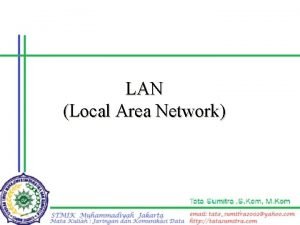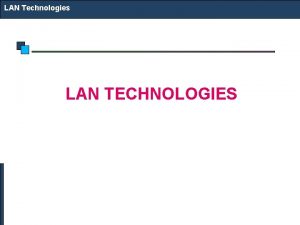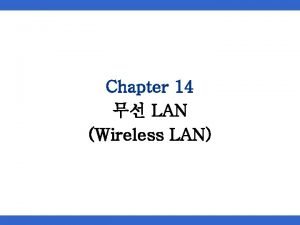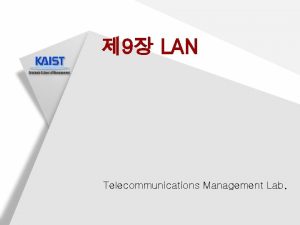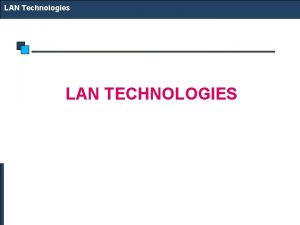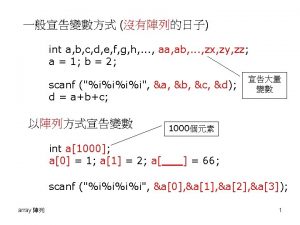10 DAYS INDUCTION COURSE FOR PGTCS14052018 23052018 LAN








































- Slides: 40

10 DAYS INDUCTION COURSE FOR PGT(CS)-(14/05/2018 -23/05/2018) LAN DESIGN IN NETWORKING Presented By: Manish Kumar Kakhani KV RLY Gandhidham (Ahmedabad Region)

Outline Definition of computer network Need for computer networking Types of computer networks( LAN, MAN and WAN ) LAN design goals LAN design considerations LAN design methodology Network topologies

What is computer network? It is defined as interconnection of multiple computers and devices

Need of computer Networking Sharing of files Sharing of software resources( Database etc. ) Sharing of Hardware resources(Printer, CPU, Hard disk etc. ) Communication between devices Facilitate collaborative project work Increased storage and processing capacity Improves work efficiency Cost effective

Types of Computer Networks ( Based on Geographical Area) Personal Area Network(PAN) Local Area Network( LAN) Metropolitan area network(MAN) Wide Area Network(WAN)

Personal Area Network(PAN) Area Covered : Around a person( very small) Data transfer rate : High Range : upto 10 metres Media : Bluetooth (wireless), Phone connected to computer Cost : Very low

Personal Area Network( PAN)

Local Area Network(LAN) Area covered : building, school, home etc. Data transfer rate : High Range : Upto 1 KM Media : Guided(twisted pair, coaxial, optical fibre) Cost : Low


Metropolitan area network(MAN) Area covered: city, town etc. Data transfer rate : Medium Range : 1 - 100 KM Media : Uses guided as well as unguided media Cost : High


Metropolitan area network(MAN)

Wide Area Network(WAN) Area covered : country, continent Data transfer rate : Low Range : More than 100 KM Media : Unguided media( wireless) Cost : Very High



LAN Design goals Functionality - the network must work with reasonable speed and reliability. Scalability - the network must be able to grow without any major changes to the overall design. Adaptability - the network must be designed with an eye toward future technologies, and should include no element that would limit implementation of new technologies as they become available. Manageability - the network would be designed to facilitate network monitoring and management.

LAN Design Considerations To maximize available LAN bandwidth and performance: The function and placement of servers Collision detection issues Segmentation issues Broadcast domain issues

LAN Design Methodology Gather and Analyze customer’s requirements Choose and Develop LAN structure (topology) Set up addressing and routing

Network Topology The schematic description of the arrangement of network It refers to actual geometric layout of computers and other devices connected to the network

Types of Network Topology Bus Topology Star Topology Ring Topology Mesh Topology Hybrid Topology

Bus Topology All the computers and devices are connected to a single cable(Backbone)

When a node wants to communicate with the other node in the network, it simply sends the message to the common bus. All the nodes in the network then receive the message but the node for which it was actually sent only processes it. The other nodes discard the message

Advantages-Bus Topology Suitable for small network Requires less cable length Easy to set up and extend Cost is less

Disadvantages- Bus topology Failure in the main cable results in shutting down of the entire network In case to network shut down, it becomes very difficult to identify the problem As the number of nodes increases , the speed of the network slows down.

Star topology In this topology, each node is connected to a central hub( or server)

When a node wants to send a message to the other nodes, it first sends the message to the hub, which in turn forward the message to the intended node. Each node in the network is connected with a point-to-point link to the centralized hub. The hub can detect the faulty node in the network as well as manages the data transmission in the network.

Advantages-star topology Easy error detection and correction Failure of any other node (except the hub) does not affect the network Easy to install New nodes can be connected easily Network does not get disturbed when any device is added or removed from it

Disadvantages-star topology If the central hub fails , the entire network shuts down It requires more cable length than bus topology It is more expensive than bus topology because of the cost of hubs, cables etc.

Ring Topology All the nodes are connected to each other in the shape of a closed loop Every node is connected directly to two other nodes, one on either side of it. Each device acts as a repeater to keep the signal strong as it travels

The node, which wants to send a message , first passes the message to its consecutive node in the network. Data is transmitted either clockwise or anticlockwise direction.

Advantages- Ring Topology Each node has an equal access to other nodes in the network Easy to configure and install It can span over larger distances Best suited for networks that do not have hub

Disadvantages-Ring Topology If one node fails, the entire network is shut down because the ring is not complete It is difficult to add or remove nodes from the network. In case of network failure , it is difficult to diagnose the network. It is relatively expensive

Mesh Topology Every node is connected to every other node on the network using a separate physical link(point-to-point mode).

Advantages-Mesh Topology Message delivery is more reliable Network congestion is minimum due to large number of links. Failure of a node does not affect the entire network; only the communication with that particular node is affected Communication is fast as there is a direct link between the nodes. Easy to detect network errors

Disadvantages-Mesh Topology It is most expensive network as , for n nodes, nx (n-1)/2 physical links(cables) are required. It is difficult to configure and install

Hybrid topology Network topologies- Bus, star, Ring and mesh have its own advantages and disadvantages. In real world , a pure network topology is rarely used. Combination of two or more topologies is preferred ( Hybrid topology)

Hybrid Topology-diagram

Advantages-Hybrid topology More effective as it uses multiple topologies It contains the best and efficient features of the combined topologies from which it is contructed

Disadvantages-Hybrid topology Relatively more complex Difficult to configure and install

THANK YOU
 Hwu exam timetable
Hwu exam timetable Hwu exam timetable
Hwu exam timetable Chaine parallèle muscle
Chaine parallèle muscle Sailor course brick
Sailor course brick Course title and course number
Course title and course number Urban torhamn
Urban torhamn Hur stor skarns är det för ett barn att få cancer
Hur stor skarns är det för ett barn att få cancer Boverket ka
Boverket ka Strategi för svensk viltförvaltning
Strategi för svensk viltförvaltning Variansen formel
Variansen formel Ledningssystem för verksamhetsinformation
Ledningssystem för verksamhetsinformation Tack för att ni har lyssnat
Tack för att ni har lyssnat Vad står k.r.å.k.a.n för
Vad står k.r.å.k.a.n för Centrum för kunskap och säkerhet
Centrum för kunskap och säkerhet Läkarutlåtande för livränta
Läkarutlåtande för livränta Klassificeringsstruktur för kommunala verksamheter
Klassificeringsstruktur för kommunala verksamheter Inköpsprocessen steg för steg
Inköpsprocessen steg för steg Påbyggnader för flakfordon
Påbyggnader för flakfordon Tack för att ni lyssnade
Tack för att ni lyssnade Egg för emanuel
Egg för emanuel Atmosfr
Atmosfr Personlig tidbok
Personlig tidbok Rutin för avvikelsehantering
Rutin för avvikelsehantering Vad är vanlig celldelning
Vad är vanlig celldelning Presentera för publik crossboss
Presentera för publik crossboss Fspos vägledning för kontinuitetshantering
Fspos vägledning för kontinuitetshantering Myndigheten för delaktighet
Myndigheten för delaktighet Att skriva en debattartikel
Att skriva en debattartikel Var 1721 för stormaktssverige
Var 1721 för stormaktssverige Tobinskatten för och nackdelar
Tobinskatten för och nackdelar Referat mall
Referat mall Varför kallas perioden 1918-1939 för mellankrigstiden?
Varför kallas perioden 1918-1939 för mellankrigstiden? Programskede byggprocessen
Programskede byggprocessen Start för skala
Start för skala Fimbrietratt
Fimbrietratt Uppställning multiplikation
Uppställning multiplikation Rådet för byggkompetens
Rådet för byggkompetens Lufttryck formel
Lufttryck formel Elektronik för barn
Elektronik för barn Tack för att ni har lyssnat
Tack för att ni har lyssnat Borra hål för knoppar
Borra hål för knoppar













































